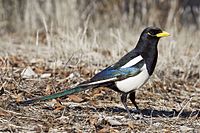Yellow-billed magpie facts for kids
Quick facts for kids yellow-billed magpie |
|
|---|---|
 |
|
| Adult | |
| Conservation status | |
| Scientific classification | |
| Kingdom: | |
| Class: | |
| Order: | |
| Family: | |
| Genus: | |
| Binomial name | |
| Pica nuttalli Audubon, 1837
|
|
 |
|
The yellow-billed magpie (Pica nuttalli) is a special type of magpie and a songbird. It is a medium-sized bird in the crow family. This bird has shiny black and white feathers and a bright yellow beak.
You can only find the yellow-billed magpie in California, USA. It likes to live in dry, warm oak savannah areas and shady valleys, especially near the Central Valley. This magpie is an omnivore, which means it eats both plants and animals. Its main foods are insects and seeds. It also eats dead animals (called carrion), small animals with backbones (like lizards), and eggs.
Yellow-billed magpies start their breeding season in April. Their young birds, called chicks, are usually ready to fly by the end of June. These birds build their nests in groups, forming loose colonies with 3 to 30 nests. They also like to find food together in large groups of many dozens of birds.
Contents
Discovering the Yellow-Billed Magpie
The famous artist and naturalist John James Audubon was the first person to officially describe the yellow-billed magpie. He gave it the name "Corvus nuttalli" to honor another naturalist, Thomas Nuttall.
How Magpies Are Related
The yellow-billed magpie is closely related to the North American black-billed magpie (P. hudsonia). Both of these magpie species came from a common ancestor. This ancestor bird traveled from the Kamtchatka area to Alaska a very long time ago, during the Pleistocene Ice Age.
Over time, the black-billed and yellow-billed magpies became different species. This happened because large glaciers formed in the Rocky Mountains. The yellow-billed magpie became separated and lived only in the warm climate of California. It then adapted to this specific environment.
Protecting the Yellow-Billed Magpie
The number of yellow-billed magpies dropped a lot after 1999. This was due to an outbreak of the West Nile Virus. Even though the species is not currently considered in danger of extinction, the virus is still a big threat. Losing their habitat (the places where they live) also puts some groups of these birds at serious risk.
Images for kids
-
Yellow-billed magpie with a black-tailed deer in California
See also
 In Spanish: Urraca de Nuttall para niños
In Spanish: Urraca de Nuttall para niños



